HONDA CR-V 2002 RD4-RD7 / 2.G Owners Manual
Manufacturer: HONDA, Model Year: 2002, Model line: CR-V, Model: HONDA CR-V 2002 RD4-RD7 / 2.GPages: 372, PDF Size: 4.49 MB
Page 261 of 372
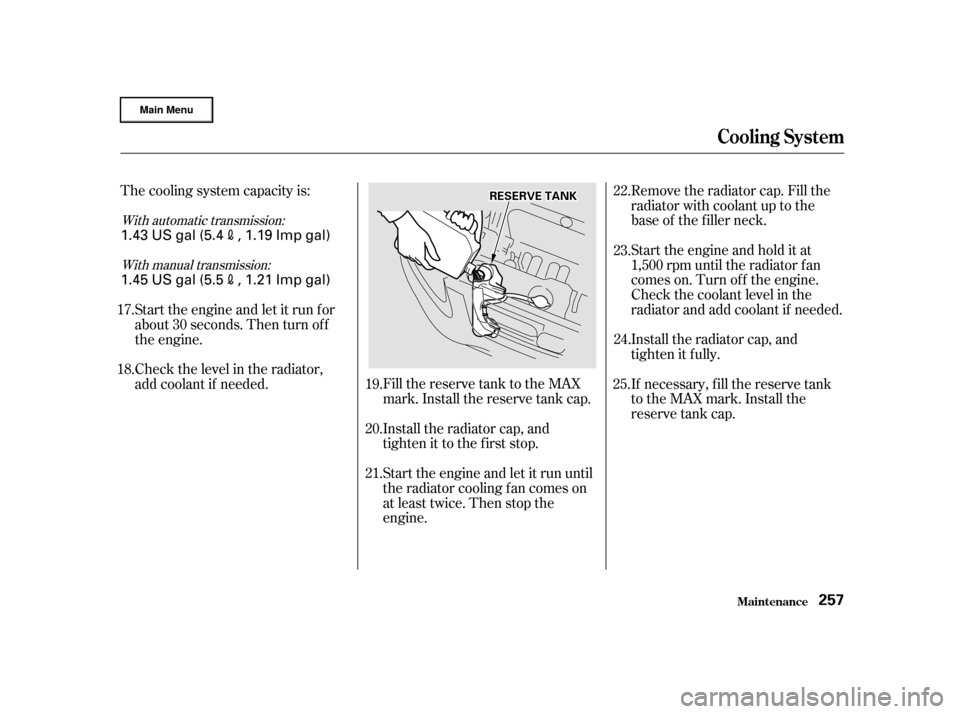
Fill the reserve tank to the MAX
mark. Install the reserve tank cap.
Install the radiator cap, and
tighten it to the first stop.Remove the radiator cap. Fill the
radiator with coolant up to the
base of the f iller neck.
Start the engine and hold it at
1,500 rpm until the radiator f an
comes on. Turn of f the engine.
Check the coolant level in the
radiator and add coolant if needed.
Install the radiator cap, and
tighten it fully.
If necessary, f ill the reserve tank
to the MAX mark. Install the
reserve tank cap.
Start the engine and let it run until
the radiator cooling f an comes on
at least twice. Then stop the
engine.
Start the engine and let it run f or
about 30 seconds. Then turn of f
the engine.
Check the level in the radiator,
add coolant if needed.
The cooling system capacity is:
17.
18. 19.
20.
21.22.
23.
24.
25.
With automatic transmission:
With manual transmission:
Maint enance
Cooling Syst em
257
R REES
SE ER
RV V E
E T
TA
A N
NK K
1.43 US gal (5.4, 1.19 Imp gal)
1.45 US gal (5.5
, 1.21 Imp gal)
Page 262 of 372
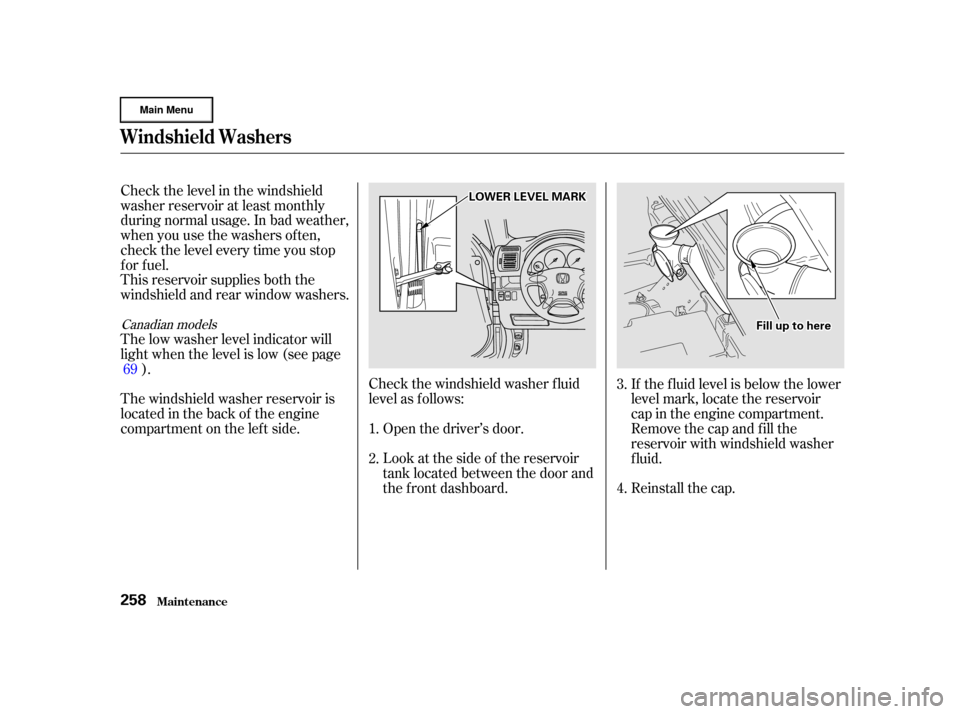
Check the windshield washer f luid
level as f ollows:Open the driver’s door.
Look at the side of the reservoir
tank located between the door and
the f ront dashboard.
Check the level in the windshield
washer reservoir at least monthly
during normal usage. In bad weather,
when you use the washers of ten,
check the level every time you stop
for fuel.
This reservoir supplies both the
windshield and rear window washers.
The low washer level indicator will
light when the level is low (see page
).
The windshield washer reservoir is
located in the back of the engine
compartment on the lef t side. If the f luid level is below the lower
level mark, locate the reservoir
cap in the engine compartment.
Remove the cap and fill the
reservoir with windshield washer
f luid.
Reinstall the cap.
1.
2.
69
3.
4.
Canadian models
Windshield Washers
Maint enance258
L LOOW WE ER
R L
LEE V
V E
EL
L M
M A
AR
RKK
F
Fiillll u
u p
p t
too h
he
erree
Page 263 of 372

Fill the reservoir with a good-quality
windshield washer f luid. This
increases the cleaning capability and
prevents f reezing in cold weather.
When you ref ill the reservoir, clean
the edges of the windshield wiper
blades with windshield washer f luid
on a clean cloth. This will help to
condition the blade edges.
Windshield Washers
Maint enance259
Do not use engine antif reeze or a
vinegar/water solution in the
windshield washer reservoir.
Antif reeze can damage your vehicle’s
paint, while a vinegar/water solution
can damage the windshield washer
pump.
Use only commercially-available
windshield washer f luid.
Page 264 of 372
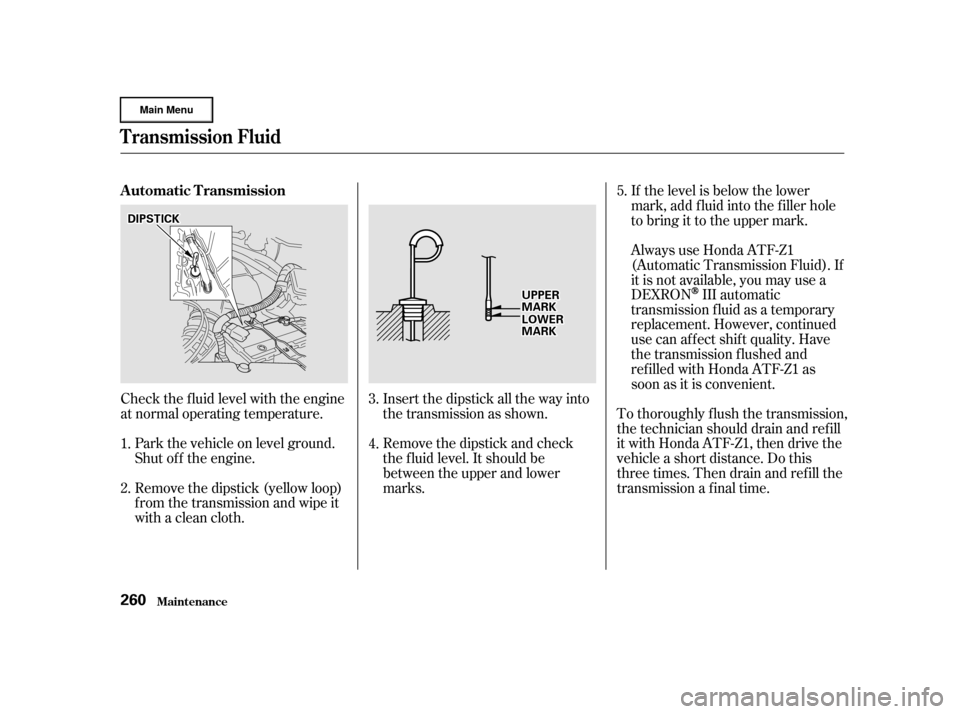
Remove the dipstick and check
the f luid level. It should be
between the upper and lower
marks.
Remove the dipstick (yellow loop)
f rom the transmission and wipe it
with a clean cloth. Park the vehicle on level ground.
Shut of f the engine.
Check the f luid level with the engine
at normal operating temperature.
Insert the dipstick all the way into
the transmission as shown.If the level is below the lower
mark, add f luid into the f iller hole
to bring it to the upper mark.
Always use Honda ATF-Z1
(Automatic Transmission Fluid). If
it is not available, you may use a
DEXRON
III automatic
transmission f luid as a temporary
replacement. However, continued
use can affect shift quality. Have
the transmission f lushed and
ref illed with Honda ATF-Z1 as
soon as it is convenient.
To thoroughly f lush the transmission,
the technician should drain and ref ill
it with Honda ATF-Z1, then drive the
vehicle a short distance. Do this
three times. Then drain and ref ill the
transmission a f inal time.
1.
2. 3.5.
4.
Automatic Transmission
Maint enance
T ransmission Fluid
260
D D
I
IPP S
ST TI
ICCK K
U
UPPP
PE
ER
R
M
M A
AR
RKK
L
LO OW WE ER
R
M
M A
AR
RKK
Page 265 of 372
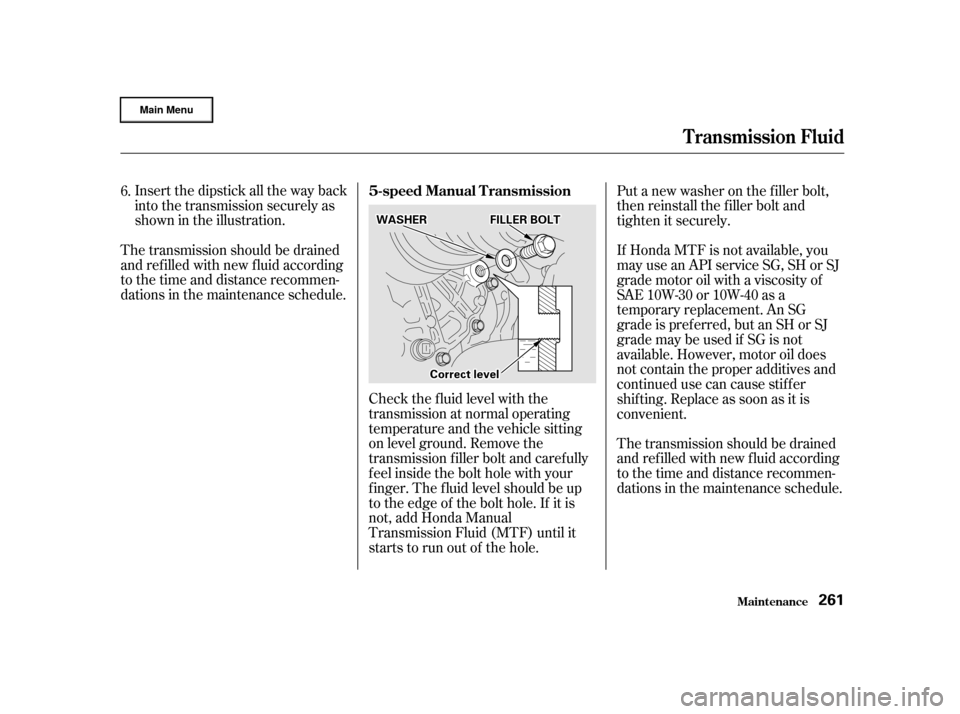
Insert the dipstick all the way back
into the transmission securely as
shown in the illustration.
The transmission should be drained
and ref illed with new f luid according
to the time and distance recommen-
dations in the maintenance schedule.
Check the f luid level with the
transmission at normal operating
temperature and the vehicle sitting
on level ground. Remove the
transmission f iller bolt and caref ully
f eel inside the bolt hole with your
f inger. The f luid level should be up
to the edge of the bolt hole. If it is
not, add Honda Manual
Transmission Fluid (MTF) until it
starts to run out of the hole.The transmission should be drained
and ref illed with new f luid according
to the time and distance recommen-
dations in the maintenance schedule. If Honda MTF is not available, you
may use an API service SG, SH or SJ
grade motor oil with a viscosity of
SAE 10W-30 or 10W-40 as a
temporary replacement. An SG
grade is pref erred, but an SH or SJ
grade may be used if SG is not
available. However, motor oil does
not contain the proper additives and
continued use can cause stif f er
shif ting. Replace as soon as it is
convenient. Put a new washer on the f iller bolt,
then reinstall the f iller bolt and
tighten it securely.
6.
5-speed Manual Transmission
T ransmission Fluid
Maint enance261
F FIILLL LEE R
R B
BOOL LTT
C
Co or
rrreec ctt l
leev veell
W
WA
AS
SHH E
ER
R
Page 266 of 372

Put a new washer on the f iller bolt,
then reinstall the f iller bolt and
tighten it securely.
Only use Honda Dual Pump Fluid.
Do not use Automatic Transmission
Fluid (ATF).
The rear dif f erential should be
drained and ref illed with new f luid
accordingtothetimeanddistance
recommendations in the mainte-
nance schedule.
Check the f luid level with the rear
dif f erential at normal operating
temperature and the vehicle sitting
on level ground. Remove the
dif f erential f luid f iller bolt and
washer and caref ully f eel inside the
bolt hole with your f inger. The f luid
level should be up to the edge of the
bolt hole. If it is not, slowly add
Honda Dual Pump Fluid until it
starts to run out of the hole.
Rear Dif f erential Fluid
Maint enance
4WD models only
262
C Co or
rrreec ctt
l
le ev veell W
WA
AS
SHH E
ER
R
F
FI ILLL LEE R
R B
BOOL LTT
Page 267 of 372
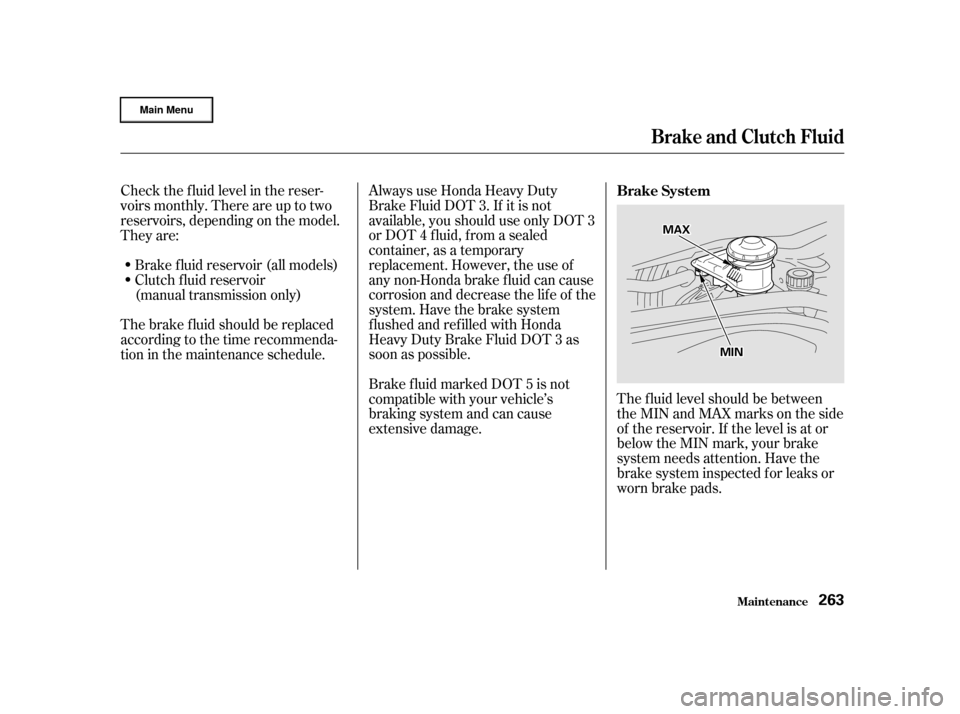
The f luid level should be between
theMINandMAXmarksontheside
of the reservoir. If the level is at or
below the MIN mark, your brake
system needs attention. Have the
brake system inspected f or leaks or
worn brake pads.
Always use Honda Heavy Duty
Brake Fluid DOT 3. If it is not
available, you should use only DOT 3
or DOT 4 f luid, f rom a sealed
container, as a temporary
replacement. However, the use of
any non-Honda brake fluid can cause
corrosion and decrease the lif e of the
system. Have the brake system
f lushed and ref illed with Honda
Heavy Duty Brake Fluid DOT 3 as
soon as possible.
Check the f luid level in the reser-
voirs monthly. There are up to two
reservoirs, depending on the model.
They are:
Brake f luid reservoir (all models)
Clutch f luid reservoir
(manual transmission only)
The brake f luid should be replaced
according to the time recommenda-
tion in the maintenance schedule. Brake f luid marked DOT 5 is not
compatible with your vehicle’s
braking system and can cause
extensive damage.Brake System
Brake and Clutch Fluid
Maint enance263
M M
A
AX
X
M
MI
INN
Page 268 of 372
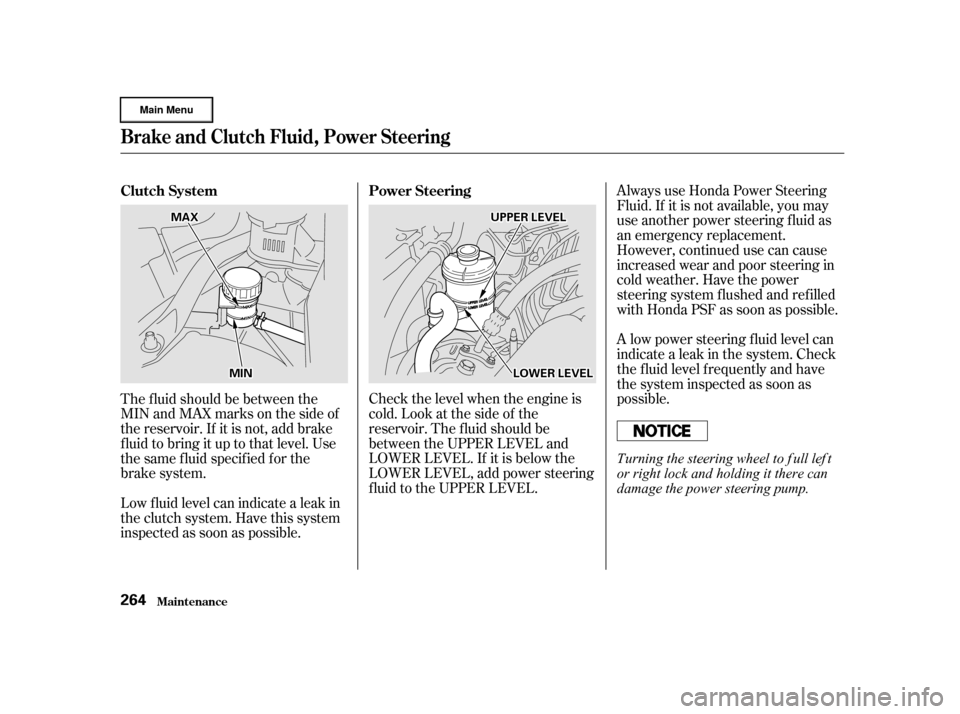
Always use Honda Power Steering
Fluid. If it is not available, you may
use another power steering f luid as
an emergency replacement.
However, continued use can cause
increased wear and poor steering in
cold weather. Have the power
steering system f lushed and ref illed
with Honda PSF as soon as possible.
A low power steering f luid level can
indicate a leak in the system. Check
the f luid level f requently and have
the system inspected as soon as
possible.
Check the level when the engine is
cold. Look at the side of the
reservoir. The f luid should be
between the UPPER LEVEL and
LOWER LEVEL. If it is below the
LOWER LEVEL, add power steering
f luid to the UPPER LEVEL.
The f luid should be between the
MIN and MAX marks on the side of
the reservoir. If it is not, add brake
f luid to bring it up to that level. Use
the same f luid specif ied f or the
brake system.
Low f luid level can indicate a leak in
the clutch system. Have this system
inspected as soon as possible. Power Steering
Clutch System
Maint enance
Brake and Clutch Fluid, Power Steering
264
L LO OW WE ER
R L
LEE V
V E
EL
L
M
M
A
AX
X U
UPPP
PE
ER
R L
LEE V
V E
EL
L
M
M I
INN
T urning the steering wheel to f ull lef t
or right lock and holding it there can
damage the power steering pump.
Page 269 of 372
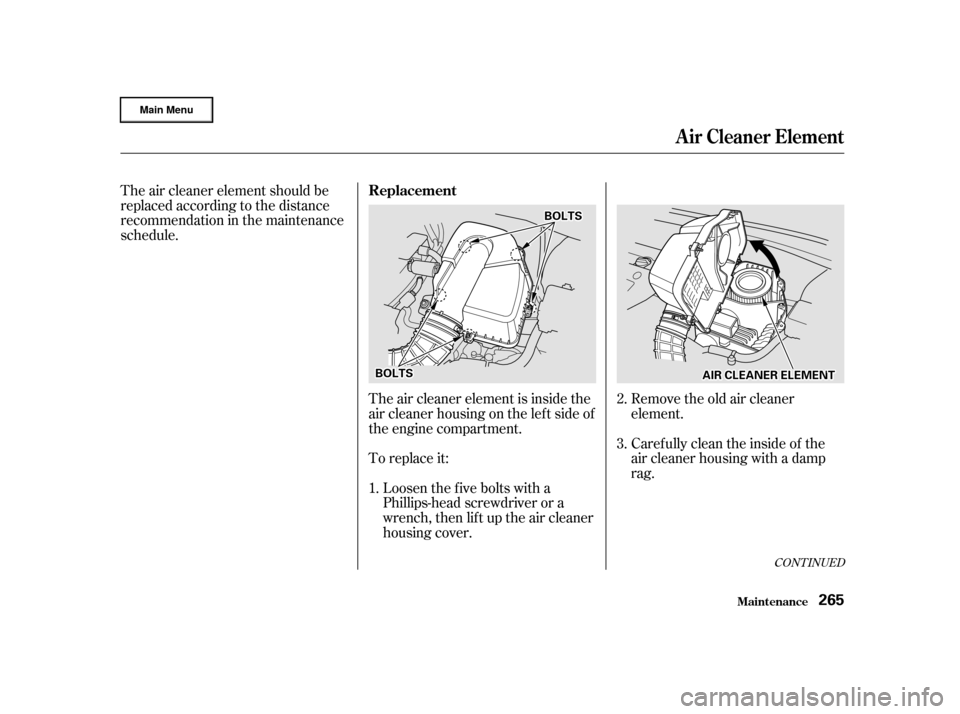
To replace it:
The air cleaner element should be
replaced according to the distance
recommendation in the maintenance
schedule.
The air cleaner element is inside the
air cleaner housing on the lef t side of
the engine compartment.Loosen the five bolts with a
Phillips-head screwdriver or a
wrench, then lif t up the air cleaner
housing cover. Remove the old air cleaner
element.
Caref ully clean the inside of the
air cleaner housing with a damp
rag.
1. 2.
3.
CONT INUED
Replacement
A ir Cleaner Element
Maint enance265
B BO
OL LTT S
S
A
AI
IRR C
CLLEE A
A N
NE ER
R E
EL
LEE M
M E
EN
NT T
B
BO
OL LTT S
S
Page 270 of 372
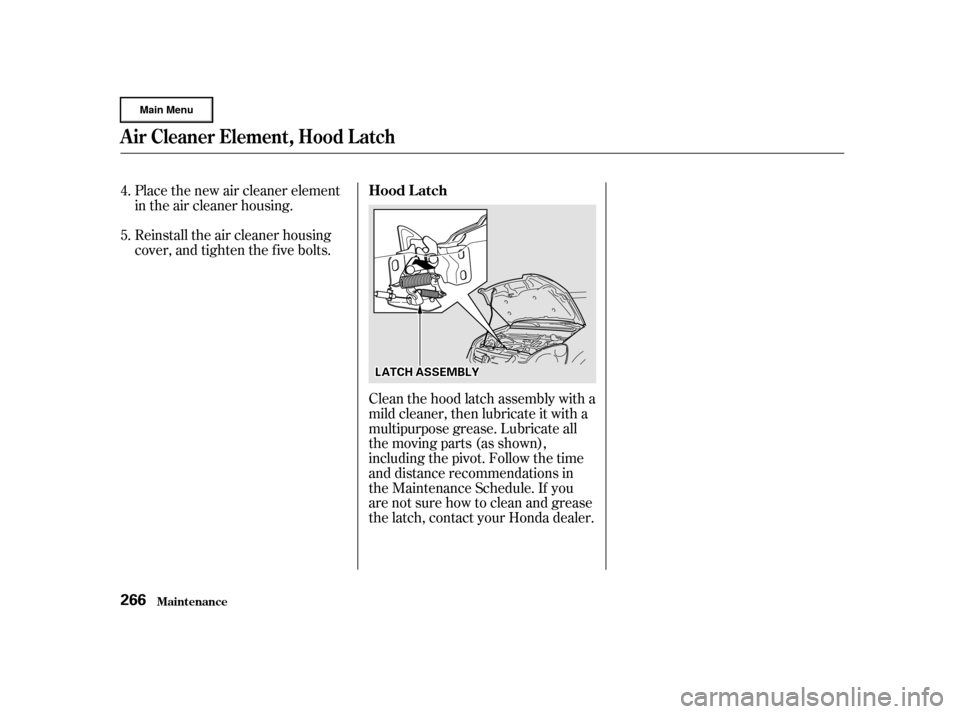
Place the new air cleaner element
in the air cleaner housing.
Reinstall the air cleaner housing
cover, and tighten the five bolts.Clean the hood latch assembly with a
mild cleaner, then lubricate it with a
multipurpose grease. Lubricate all
the moving parts (as shown),
including the pivot. Follow the time
and distance recommendations in
the Maintenance Schedule. If you
are not sure how to clean and grease
the latch, contact your Honda dealer.
4.
5.
A ir Cleaner Element, Hood L atch
Maint enance
Hood L atch
266
L LA
A T
TC
CH H A
AS
SSSEEM
M B
BLLYY